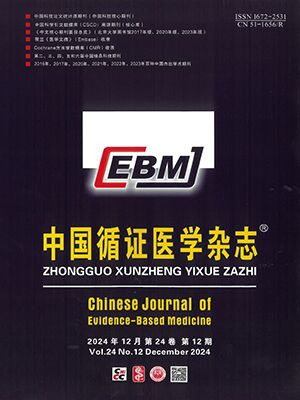| 1. |
Boden SD. Overview of biology of lumbar spine fusion and principles for selecting a bone graft substitute. Spine, 2002, 27(16 Suppl 1): 26-31.
|
| 2. |
Helm GA, Dayoub H, Jane JA Jr. Bone graft substitutes for the promotion of spinal arthrodesis. Neurosurg Focus, 2001, 10(4): E4.
|
| 3. |
Vaccaro AR, Chiba K, Heller JG, et al. Bone grafting alternatives in spinal surgery. Spine J, 2002, 2(3): 206-215.
|
| 4. |
Guyatt GH, Rennie D. The evidence-based medicine working group. Users’ guides to the medical literature: A manual for evidence-based clinical practice. Chicago: AMA Press, 2002.
|
| 5. |
Burkus JK, Heim SE, Gornet MF, et al. Is INFUSE bone graft superior to autograft bone? An integrated analysis of clinical trials using the LT-CAGE lumbar tapered fusion device. J Spinal Disord Tech, 2003, 16(2): 113-122.
|
| 6. |
Garrison KR, Donell S, Ryder J, et al. Clinical effectiveness and cost effectiveness of bone morphogenetic proteins in the non-heal ing of fractures and spinal fusion: a systematic review. Health Technol Assess, 2007, 11(30): 1-150, iii-iv.
|
| 7. |
Boden SD, Zdebl ick TA, Sandhu HS, et al. The use of rhBMP-2 in interbody fusion cages. Definitive evidence of osteoinduction in humans: a preliminary report. Spine, 2000, 25(3): 376-381.
|
| 8. |
Dimar JR, Glassman SD, Burkus KJ, et al. Clinical outcomes and fusion success at 2 years of single-level instrumented posterolateral fusions with recombinant human bone morphogenetic protein-2/ compression resistant matrix versus iliac crest bone graft. Spine, 2006, 31(22): 2534-2539; discussion 2540.
|
| 9. |
Glassman SD, Dimar JR, Carreon LY, et al. Initial fusion rates with recombinant human bone morphogenetic protein-2/compression resistant matrix and a hydroxyapatite and tricalcium phosphate/ collagen carrier in posterolateral spinal fusion. Spine, 2005, 30(15): 1694-1698.
|
| 10. |
Vaccaro AR, Patel T, Fischgrund J, et al. A pilot study evaluating the safety and efficacy of OP-1 Putty (rhBMP-7) as a replacement for iliac crest autograft in posterolateral lumbar arthrodesis for degenerative spondylolisthesis. Spine, 2004, 29(17): 1885-1892.
|
| 11. |
Kanayama M, Hashimoto T, Shigenobu K, et al. A prospective randomized study of posterolateral lumbar fusion using osteogenic protein-1 (OP-1) versus local autograft with ceramic bone substitute: emphasis of surgical exploration and histologic assessment. Spine, 2006, 31(10): 1067-1074.
|
| 12. |
Johnsson R, Stromqvist B, Aspenberg P. Randomized radiostereometric study comparing osteogenic protein-1 (BMP-7) and autograft bone in human noninstrumented posterolateral lumbar fusion: 2002 Volvo Award in clinical studies. Spine, 2002, 27(23): 2654-2661.
|
| 13. |
Vaccaro AR, Anderson DG, Patel T, et al. Comparison of OP-1 Putty (rhBMP-7) to iliac crest autograft for posterolateral lumbar arthrodesis: a minimum 2-year follow-up pilot study. Spine, 2005, 30(24): 2709-2716.
|
| 14. |
Haid RW Jr, Branch CL Jr, Alexander JT, et al. Posterior lumbar interbody fusion using recombinant human bone morphogenetic protein type 2 with cylindrical interbody cages. Spine J, 2004, 4(5): 527-38; discussion 538-539.
|
| 15. |
Burkus JK, Gornet MF, Dickman CA, et al. Anterior lumbar interbody fusion using rhBMP-2 with tapered interbody cages. J Spinal Disord Tech, 2002, 15(5): 337-349.
|
| 16. |
Burkus JK, Sandhu HS, Gornet MF. Influence of rhBMP-2 on the heal ing patterns associated with allograft interbody constructs in comparison with autograft. Spine, 2006, 31(7): 775-781.
|
| 17. |
Burkus JK, Transfeldt EE, Kitchel SH, et al. Clinical and radiographic outcomes of anterior lumbar interbody fusion using recombinant human bone morphogenetic protein-2. Spine, 2002, 27(21): 2396-2408.
|
| 18. |
Burkus JK, Dorchak JD, Sanders DL. Radiographic assessment of interbody fusion using recombinant human bone morphogenetic protein type 2. Spine, 2003, 28(4): 372-377.
|
| 19. |
Coric D, Fischgrund JS, Patel T, et al. 772 Two-year follow-up on patients in a pilot safety and efficacy study of OP-1 (rhBMP-7) in posterolateral lumbar fusion as a replacement for iliac crest autograft neurological surgeons. Neurosurg, 2004, 55(2): 477.
|
| 20. |
Ackerman SJ, Mafilios MS, Polly DW. Economic evaluation of bone morphogenetic protein versus autogenous iliac crest bone graft in single-level anterior lumbar fusion: an evidence-based model ing approach. Spine, 2002, 27(16 Suppl 1): S94-99.
|
| 21. |
Anand N, Hamilton JF, Perri B, et al. Cantilever TLIF with structural allograft and RhBMP2 for correction and maintenance of segmental sagittal lordosis: long-term clinical, radiographic, and functional outcome. Spine, 2006, 31(20): E748-753.
|
| 22. |
Mummaneni PV, Pan J, Haid RW, et al. Contribution of recombinant human bone morphogenetic protein-2 to the rapid creation of interbody fusion when used in transforaminal lumbar interbody fusion: a preliminary report. J Neurosurg Spine, 2004, 1(1): 19-23.
|
| 23. |
Joseph V, Rampersaud YR. Heterotopic bone formation with the use of rhBMP2 in posterior minimal access interbody fusion: a CT analysis. Spine, 2007, 32(25): 2885-2890.
|
| 24. |
Boden SD, Kang J, Sandhu H, et al. Use of recombinant human bone morphogenetic protein-2 to achieve posterolateral lumbar spine fusion in humans: a prospective, randomized clinical pilot trial: 2002 Volvo Award in clinical studies. Spine, 2002, 27(23): 2662-2673.
|
| 25. |
Sasso RC, LeHuec JC, Shaffrey C. Iliac crest bone graft donor site pain after anterior lumbar interbody fusion: a prospective patient satisfaction outcome assessment. J Spinal Disord Tech, 2005, 18(Suppl): S77-81.
|




